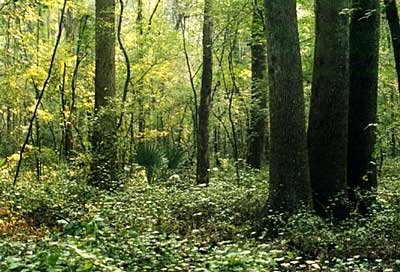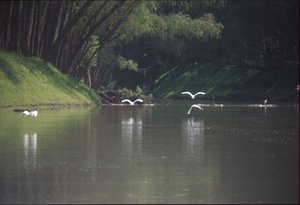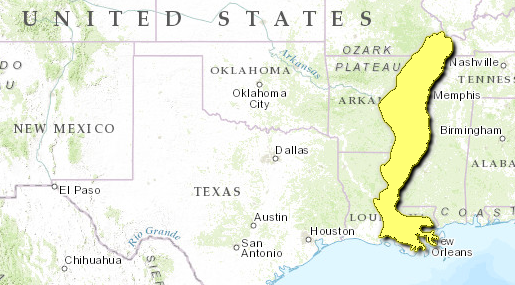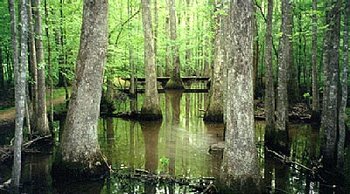Mississippi lowland forests

Eastern Louisiana, USA. (Photograph by U.S. Fish & Wildlife Services)
ContentsWWF Terrestrial Ecoregions Collection |
Introduction
The Mississippi lowland forests ecoregion (Mississippi lowland forests) occurs in the floodplain of the Mississippi River and runs north from Louisiana to the southern tip of Illinois. It is separated from surrounding ecoregions by topography, floodplain dynamics, and vegetation. While chiefly lying along the Mississippi floodplain, the ecoregion also lies along the lowest reaches of the Arkansas River near the discharge point to the Mississippi. Surrounding ecoregions typically support more xeric conifer-dominated forests on upland landscapes. The Mississippi lowland forests were very similar in composition to the magnificent bottomland forests that occur along the rivers found in the Middle Atlantic coastal forests. However, virtually all of the remaining riparian forests of this ecoregion are gone, making it one of the most heavily converted ecoregions in the USA.
Biological Distinctiveness
The Mississippi lowland forests serve as an important part of a major flyway route used by migratory birds. The rich bottomland forests once contained some of the most interesting hardwood communities in the United States but these are virtually all cleared.
The natural vegetation is dominated by bottomland hardwood forests, primarily oak-hickory-pine forests. Küchler describes this region as a dense medium tall to tall forest of broadleaf deciduous and evergreen trees and shrubs and needleleaf deciduous trees that occurs along river and stream floodplains. During the last period of glaciation, it is likely that major river channels served as important pathways for migrating species. As a result, a mixing of upland and bottomland species occurred. Consequently,, this ecoregion includes species from the mixed mesophytic forests, the Appalachian-Blue Ridge forests, and the central hardwoods.
Bottomland hardwood forests represented the majority of the inland wetland acreage in the United States during European colonization. Historical descriptions report that these areas grew cypress, gum, hickory, oak, and cedar as their major overstory components. Virgin stands of cypress were typically 400-600 years old at the time of European settlement. Over the last century most of these lands have been logged and few individuals over 200 years old remain.
 Egret species (Egretta sp.), Western Mississippi, USA. (Photograph by U.S. Fish & Wildlife Services) The most important environmental condition in this ecoregion is the hydroperiod, which controls the amount of oxygen and moisture available to the forest communities. The floodplain forest communities can be segregated into different species assemblages, based on the hydroperiod. They include, in decreasing flood duration, river swamp forests, lower hardwood swamp forests, backwater and flats forests, and upland transitional forests. River swamp forests, which are adapted to continuous flooding, contain baldcypress (Taxodium distichum) and water tupelo (Nyssa aquatica), which often codominate the canopy. Associated with river swamp forests are button bush (Cephalanthus occidentalis), water ash (Fraxinus caroliniana), water-elm (Planera aquatica), and black willow (Salix nigra). Lower hardwood swamp forests are similar to river swamp forests, but have a more diverse woody community. Water hickory (Carya aquatica), red maple (Acer rubrum), green ash (Fraxinus pennsylvanica) and river birch (Betula nigra) increase in prevalence. Common herbs include butterweed (Senecio glabellus), jewelweed (Impatiens capensis), and royal fern (Osmunda regalis). Forests of backwaters or flats make up a third zone, and are seasonally saturated. They support a greater richness of hardwood species. In addition to lower hardwood swamp species, sweetgum (Liquidamber styraciflua), sycamore (Platanus occidentalis), laurel oak (Quercus laurifolia), and willow oak (Quercus phellos) are present. Woody vines increase in abundance, including poison ivy (Toxicodendron radicans), greenbriers (Smilax spp.), and trumpet-creeper (Campsis radicans). At the transition to upland forests are ridges and dunes formed during the Pleistocene, as well as natural levees. These areas are flooded for only brief periods of time. This area is similar to the oak-hickory-pine forests of the southeastern piedmont area.
Egret species (Egretta sp.), Western Mississippi, USA. (Photograph by U.S. Fish & Wildlife Services) The most important environmental condition in this ecoregion is the hydroperiod, which controls the amount of oxygen and moisture available to the forest communities. The floodplain forest communities can be segregated into different species assemblages, based on the hydroperiod. They include, in decreasing flood duration, river swamp forests, lower hardwood swamp forests, backwater and flats forests, and upland transitional forests. River swamp forests, which are adapted to continuous flooding, contain baldcypress (Taxodium distichum) and water tupelo (Nyssa aquatica), which often codominate the canopy. Associated with river swamp forests are button bush (Cephalanthus occidentalis), water ash (Fraxinus caroliniana), water-elm (Planera aquatica), and black willow (Salix nigra). Lower hardwood swamp forests are similar to river swamp forests, but have a more diverse woody community. Water hickory (Carya aquatica), red maple (Acer rubrum), green ash (Fraxinus pennsylvanica) and river birch (Betula nigra) increase in prevalence. Common herbs include butterweed (Senecio glabellus), jewelweed (Impatiens capensis), and royal fern (Osmunda regalis). Forests of backwaters or flats make up a third zone, and are seasonally saturated. They support a greater richness of hardwood species. In addition to lower hardwood swamp species, sweetgum (Liquidamber styraciflua), sycamore (Platanus occidentalis), laurel oak (Quercus laurifolia), and willow oak (Quercus phellos) are present. Woody vines increase in abundance, including poison ivy (Toxicodendron radicans), greenbriers (Smilax spp.), and trumpet-creeper (Campsis radicans). At the transition to upland forests are ridges and dunes formed during the Pleistocene, as well as natural levees. These areas are flooded for only brief periods of time. This area is similar to the oak-hickory-pine forests of the southeastern piedmont area.
Conservation Status
Habitat Loss
About 91-95 percent of this habitat has now been converted to agriculture or other uses, or is highly degraded. Soybean cultivation dominates land-use. The habitats most affected are bottomland forests, which were cleared for agriculture or harvested for timber long ago.
Remaining Blocks of Intact Habitat
Remaining habitat is confined to the wettest sites, which are difficult to exploit economically or put under cultivation. The remaining blocks are not representative of the ecoregion's major habitats. Remaining fragments include:
- Atchafalaya Area and surrounding lowlands (status/ownership uncertain) - southern Louisiana
- Crowley's Ridge (partly included in St. Francis National Forest) - northeastern Arkansas, southeastern Missouri
- Big Woods Conservation Area adjacent to USFWS refuge (TNC) - northern Louisiana
- Cache River Restoration Project - southern Illinois, southeastern Missouri, southwestern Kentucky
- Mingo National Wilderness Reserve - southeastern Missouri
- several National Wildlife Refuges of uncertain biodiversity value
Degree of Fragmentation
There is no possibility at present of connecting the existing blocks mentioned above. This ecoregion has been greatly affected by fragmentation, levee construction, and the alteration of river flow. The long-term potential of corridor restoration is low.
Degree of Protection
Poor, and protected areas do not represent typical vegetation.
Types and Severity of Threats
Because of the high degree of conversion, there is little left to conserve. Hydrologic [[alteration]s] have the greatest impact. Logging remains a threat, as does continued exploitation of remaining forests. Pollutant effects in the lower section of the ecoregion are serious.
Suite of Priority Activities to Enhance Biodiversity Conservation
- Designate Atchafalaya Area and surrounding lowlands and the Big Woods Conservation Area as protected areas and improve conservation management
- Continue funding for inter-agency planning efforts to create corridors
- Continue inventory and identification of important sites for biodiversity and protect remaining areas
Conservation Partners
- The Nature Conservancy
- The Nature Conservancy - Midwest Regional Office
- The Nature Conservancy - Southeast Regional Office
- Partners in Flight
Relationship to Other Classification Schemes
The Mississippi lowland forests corresponds to Küchler’s unig 103 (Southern floodplain forest). This ecoregion is identical to Omernik’s unit 73 (Mississippi alluvial plain) with the exception of the coastal grasslands of Louisiana, which were separated and lumped with the Western Gulf coastal grasslands, based on Küchler. Bailey’s section 234A (Mississippi alluvial basin) approximates the boundaries of this ecoregion.
Additional Information on this Ecoregion
- For a shorter summary of this entry, see the WWF WildWorld profile of this ecoregion.
- To see the species that live in this ecoregion, including images and threat levels, see the WWF Wildfinder description of this ecoregion.
| Disclaimer: This article contains nformation that was originally published by the World Wildlife Fund. Topic editors and authors for the Encyclopedia of Earth have edited its content and added new information. The use of information from the World Wildlife Fund should not be construed as support for or endorsement by that organization for any new information added by EoE personnel, or for any editing of the original content. |

